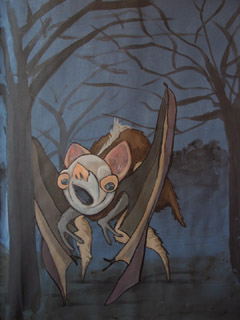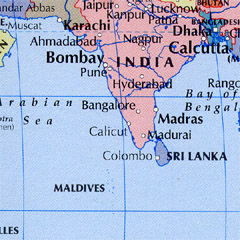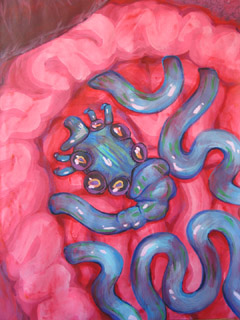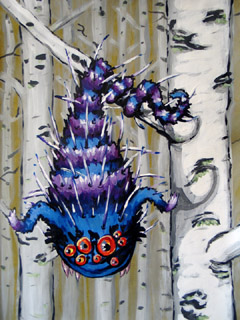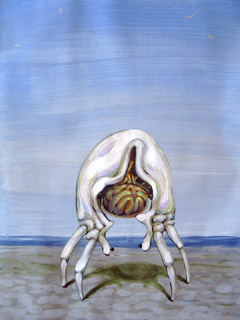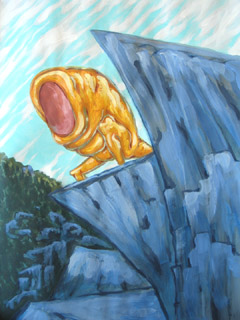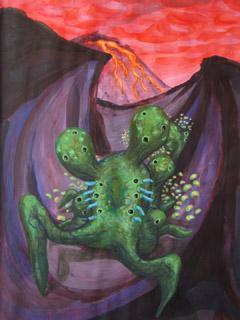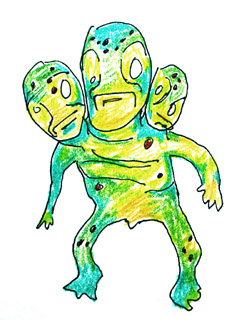 4. Confessions
4. Confessions"Sandwich?"
"Thank you."
Marooned by the one-eyed pilot on a deserted oil tanker -- somewhere deep in the southern Indian Ocean -- it seems like a good moment to have a snack and take stock of the situation. Scarlet has laid out a picnic blanket. I grimly chew on stale ham-and-rye; she's drinking chocolate milk.
"So. Care to explain?"
Scarlet casts a fiendish grin. Her straw sucks loudly at the last drops of milk.
***This is Scarlet's tale:
On our seemingly endless journey, the antsy girl was forced to entertain herself in the back of the helicopter -- while I "edumacated Mr. Judas-pants" in front. It wasn't long before she discovered his secret stash of personal belongings... Which she had ample opportunity to riffle through.
After the paddleball and yo-yo incidents, the pilot and I were more than happy get some peace. As long as she was silent, we were content to ignore what was going on behind us. Lesson learned: If Scarlet is being quiet, the
serious trouble-making must be underway.
"Tucked in cozy between his tighty-whiteys and his socks," she discovered a large wad of hundred-dollar bills. That's what tipped her off that something was amiss.
Good girl, I think,
that was probably the blood money he got paid to dispose of us.On the second oil tanker stop, when she insisted that she needed to "go potty" and "de-skankify," Scarlet was secretly angling to take a look about. It's a good thing that she did, too. Those big canvas-covered crates -- they were full of weapons. The Pilot, it seems, mixes with very bad company.
Given how things were shaping up, Scarlet thought it prudent to "yank an insurance policy" for herself.
"But a bazooka?"
"Oh! Don't worry -- I got something for you, too." She digs around in her bottomless rucksack and pulls out a black pistol. I take her gift gingerly and examine the thing. A "Glock Automatic Pistol" -- undoubtedly missing any serial numbers. And it's loaded. I quickly pocket it...
I hate guns.
5. The Hideous HoldTime to explore.
The last oil tanker where we stopped had no crew on deck -- but it did have two helicopters and cargo strapped down. Here, there's not even that.
"Ooh! Let's go downstairs! I wanna see what makes this tankahr so very, very
supahr."
"We should check the bridge and living quarters first," I grunt.
"I call Scarlet-Saves-The-Day --
Again -- privilege! Maybe they've got
KONG down there."
She's bouncing up and down on her toes.
Oh, alright...***Down, down the ladder, from a circular hatch on the deck... Five stories down into the dark hold. The light from above is all we have to see by.
The compartment is empty and echoes with our footsteps. It takes our eyes a few minutes to adjust. This enormous man-made space, it is a marvel...
"Spooooky door! What do you think, Ms. Murdersville Slumbercamp co-ed -- shall we take go take a look? Why, yes -- I think so. Abso-freakin'-lutely."
I cut Scarlet off at the door -- a heavy metal thing, windowless, with a wheel that turns to lock it shut. A crowbar has been stuck through the wheel, preventing it from turning.
"Permit
me."
I put my ear to the door. Nothing.
I rap on the door loudly. Again, my ear to the door. Nothing.
The crowbar slides out, and I pass it to my assistant. She weighs it in her hands, appreciatively.
I spin the wheel -- and give the door a shove to open it up a crack.
***My heart leaps in my chest.
Monsters!Perhaps forty of them... Moving lethargically about the cavernous compartment.
Dark red flesh, four spider-like legs dragging a bloated and bulbous living mass along the floor, two more stiff limbs sticking straight up into the air. So alien... But then I realize what I am looking at--
Men! These were human beings! Something has transformed them. The limbs sticking up in the air were legs... In the main mass, I can just make out human faces -- distended almost beyond recognition. The entire being has been flipped upside-down; the things I mistook for legs are what used to be arms -- split in two where the radius and ulna would usually connect.
My eyes begin to penetrate deeper into the murk. I realize that some of these things are still wearing shreds of clothing. In the far corner, three of the beasts are ripping gristle from the carcass of one of their compatriots. Cannibalism. Around the corners of the room, there are perhaps twenty skeletons from previous kills. So much like human bones, and yet re-shaped into something new...
A terrible nausea shoots through my stomach. I know what sort of thing causes this.
Virus.6. Dear DiarySeveral of the creatures suddenly perk up. With a hideous writhing gait, they begin shambling toward freedom.
I slam the door shut and spin the wheel. "Crowbar?"
"Crowbar." Scarlet hands me the tool, and I wedge it in, locking the door shut again.
***Back topside, we've searched the bridge and found nothing informative. Now we're going through the living quarters, one room at a time.
Most viruses need some sort of fluid for transmission. I think there's good reason to hope that we haven't been infected yet -- but as a precaution, I break open a first aid kit to get us some latex gloves and face masks. "Nurse Scarlet" loves the new look.
It's when we find the first mate's room that we get our big break.
A half-man is lying on the floor. His skin is that terrible boiled-flesh mauve of the creatures, and grapefruit-sized boils have erupted around his neck. He has shot himself through the brain. Mercifully, he's fallen so that most of the gore is hidden.
Sitting on a small desk next to his body is a red book, helpfully labeled "diary." It's the generic hard-bound page-a-day sort that one picks up in a big box office supply store.
Scarlet comes in, and sees what I've found. "Oh, it just doesn't get better than this!"
I quickly open to the last entry. Scarlet reads over my shoulder...
***The First Mate could see what was happening to him, and decided to take his own life. It had been coming on for the past two days.
He had seen what happened to the men that came from the oil drilling project. They were sick when they came on board. Then one changed. Then another. The tanker's crew had corralled them into an empty hold at gun point. But then the crew began to change, too. One-by-one, they joined the beasts in the hideous hold.
There are promises that medical help is on its way -- but no one comes. Everyone involved in this catastrophe is being abandoned. Panic and paranoia take hold; there are shootings. The captain, who hasn't changed yet, is locked up in the brig.
The First Mate apologizes to his girlfriend for ever getting involved in this mess...
What's that shuffling outside?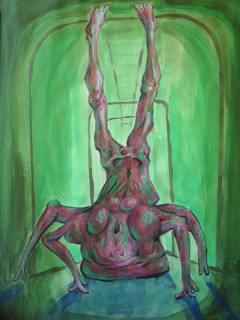 7. The Big Bang
7. The Big BangI step through the open door to the hallway.
Nothing.I peek around to the other side of the door --
MONSTER!Just behind the door, two feet from my face, one of the creatures has snuck up on us. My first impulse: I slam the door wide open, forcibly knocking the creature back a step.
"GET OUT! GO! GO!"
Scarlet leaps through the door and starts sprinting down the hall. I'm not far behind.
The thing is groping at the door... Blind and deaf, I realize -- it's trying to pick up our scent. And then it does.
I catch up with Scarlet at the end of the hallway. She's lifting the grenade launcher onto her shoulder.
"NO NO NO! KEEP GOING!"
I can tell she's miffed -- but she complies. We fly up a flight of stairs, through the bridge, out to the deck. We've outpaced it, but it's not far behind.
"The captain is locked up in the brig," I think to myself.
"What now? Hide and seek?"
"Do you have all your stuff?"
"Yep."
"Then I'd say it's time to get out of here."
***This is not my best plan ever. In fact, it's really no plan at all -- it's just taking the next step, doing the the terrible thing that must ultimately be done, no matter the cost.
Be bold.Scarlet helps me get the lifeboat in place. We lower it down to the water with an audible
splash! We climb down and begin paddling away.
A hundred feet distant isn't very far... But that's where I have us pause.
"Scarlet, would you do the honors?"
It takes a moment -- then understanding spreads across my assistant's face in a big puppy-dog grin.
"Aye, aye, captain!"
The grenade launcher hefts to her shoulder; she takes aim; I cover my ears with both hands.
BANG.
***Water starts rushing in through the side of the tanker. For safe measure I have Scarlet blow another three holes in the hull.
And then we paddle with all our might. The ship takes at least 45 minutes to go down -- but I don't want to take any chances, risking being caught in the maelstrom as its sucked under.
So we row. And then it's gone. And we're alone in a lifeboat -- hundreds of miles from land, far from any shipping lane...
 [kerguelen continent - topography]8. Adrift in a Lifeboat
[kerguelen continent - topography]8. Adrift in a LifeboatWe start rowing southward. Based on the GPS readings, it looks like we're about 350 miles away from Kerguelen. I'm worried about the ocean currents; I'm afraid they're pushing us farther and farther away from safety.
I take this opportunity to "edumacate" Scarlet a bit more.
I explain: Right now, we're actually floating over a sunken continent -- the Kerguelen Continent. It's about a third the size of the USA. Desolation Island is just the tip of it that sticks out of the water. Over the past 100 million years, it's been above sea level for three periods. We know that about 50 million years back it was covered with life. The last time that it sunk was about 20 million years ago.
This is a pretty recent discovery: it was announced back around 1999. But you see, someone was paying attention. Where prehistoric life used to be, there's a good chance that you're going to find oil. It's a terrible area to try and work in -- what with being so far away from civilization, and the terrible winds -- but isolation is just what this someone was looking for.
What do we have here? A Power with the resources to set up an illegal oil drilling operation.
That equals an independent source of fuel. It has oil tankers for moving out the crude. Probably a whole
fleet of tankers, if it can afford to be using them as floating air bases. And then there's a massive weapons smuggling operation... It sounds to me like a secret build-up to war!
But the people behind this conspiracy -- they found more than they were looking for. As the men at the drilling operation brought up the oil, they were also unearthing an ancient virus. Maybe it was native to the Kerguelen Continent 50 million years ago. Maybe it evolved underneath the ocean, in the time after the continent sank. Maybe it was even of extraterrestrial origin. (My foreign contact has suggested that there was a colony in these parts some time in the past...)
Whatever its origins, this is a zorn-producing mutagen. Those creatures that the drill crew became -- they weren't men anymore. They were zorns. We name mutants like this after the place where the affecting virus was found. So, what we saw back there on the ship -- properly speaking, those were Kerguelen Zorns.
As awful as it sounds, we have to hope that the men were infected quickly. If we're very lucky, they were just getting set up and hadn't even gotten a tanker out yet. Because if they did, and there's a ship out there somewhere carrying thousands of gallons of virus-laden fuel... I shudder to think.
But, we might be in luck. Whoever was in charge of this operation quarantined the infected men. Although, I'll bet they were just waiting to see what would happen. Maybe there were thoughts of using the virus for biological warfare. Something like this -- it'd be a far more valuable discovery than the oil alone.
Which is why it was all-important that we sink the ship. A human-affecting zorn virus
must not be loosed on the world.
And yet -- there's still the abandoned drilling operation sitting out there,
somewhere...
***"Sandwich?"
"Thank you."
Night has fallen, and we huddle for warmth together underneath a space blanket. I check the GPS again. It's bad: the currents are pushing us away from Desolation Island faster than we can row toward it.
"We're not going to make it like this. We're losing ground too fast."
"Well, phoo. It woulda been really cool."
"Yep."
"Ichbonnsen and Super Assistant Scarlet row a million billion miles... And then we step out onto land! All blistery and gnarly dreadlocks and mega-buff sailor arms -- but alive. The crowd goes wild!"
I drift into silence, thinking about how the story's actually going to end. Thirsty, sunburned, delirious...
Scarlet sees the look on my face and stops eating.
"What's the point, then, right? We've lost. Game over!"
I watch, horrified, as she tosses the last of her sandwich out into the darkness."
"Hey, don't do that!"
"Looks like we're getting out of this the easy way."
She's rummaging in her rucksack. My mind flashes to the gun she gave me, still in my pocket.
Scarlet pulls out the laptop and satellite phone.
"What's the number for pizza?"
***Our connection is on-again off-again. But through the night, Scarlet attempts to send out S.O.S. emails with our approximate location -- every two hours, regardless.
The following day it rains. We do everything we can to keep the computer from getting wet -- but this is a nerve-wracking development. The one mercy is that the ocean is still relatively calm. If the waves decide to pick up, then we're really done for.
I work on capturing as much fresh drinking water as possible.
In the afternoon the storm clears up. We do what we can to dry out our clothes. Hypothermia's a bigger threat than starvation at this point.
***We make it through another night, adrift in the lifeboat.
It's a futile endeavor, but we keep taking turns rowing, trying to head in the direction of Desolation Island.
At least it's something to do.
We eat the last of the sandwiches. Night falls.
***We're woken in the middle of the third night by something bumping against the bottom of our boat. We've been discovered --
By sharks!
We watch anxiously as they circle. We ought to be safe enough -- so long as we don't go out for a swim...
But then just around dawn, one big lout actually tries to take a bite out of us.
I beat him over the head repeatedly with my paddle, and he falls back into the water. A comically mouth-shaped crescent is missing from side of our vessel.
9. Rescue!A helicopter!
Is it coming from one of the weapons smuggling ships?No! It is a different model from the helicopters that we've become so accustomed to. It comes closer and closer -- we've been spotted!
It hovers above us. The propeller sends a fine spray of water in all directions, as dozens of fins continue spiraling around the lifeboat. A rope ladder descends. I send Scarlet up first. I follow close behind.
As a final insult, the big lout leaps up again and grabs onto the bottom rungs of the ladder. I kick his nose with all my might, steel-toed boot colliding with sandpaper skin.
He falls back down -- and at last we are free!
***Our saviors are Captain K. and First Mate Todd -- part of a multi-national science expedition working in the Kerguelen area. They are about to take us back to their main vessel for medical attention...
I protest in the strongest possible terms. We're hungry, but otherwise in good health. What is imperative is that the weapons smuggling ring be exposed -- and that the oil drilling operation gets destroyed. Were it possible, I would go to the proper authorities myself... But I know full well that no one believes the word of "crazy" Ichbonnsen. Our two rescuers, however, would make excellent, credible witnesses.
I explain what we saw on our long helicopter journey, and how we were marooned by the one-eyed pilot. When it comes to the Kerguelen Zorns, however, I hold my tongue. Instead, I say the drill crew was dying from exposure to a "biological weapon."
Even with the more colorful moments of our adventure censored, Captain K. and First Mate Todd seem to feel my story is far-fetched...
Then Scarlet pulls out her Bazooka.
That convinces them.
***We set down gently on the deserted oil tanker. The two helicopters and the many canvas-covered crates are still there -- nothing's changed. Our rescuers are truly astonished.
I hand over the red diary -- minus the last few pages, which I've torn out and hidden away. I emphasize again the dire importance of destroying the drilling operation. Then we split up to check out the rest of the ship.
While the Captain and First Mate are down below, Scarlet and I unlash one of the smugglers' helicopters. I am not a great pilot -- but my skills should be adequate to get us back to civilization.
10. Marked for DeathI hate to run off on our rescuers like this... But if we were to go back with them, I can easily imagine how events would transpire. Two mysterious individuals found in a lifeboat, claiming knowledge of a conspiracy... there'd be questions; there'd be denial; and then we'd wind up being the convenient scapegoats. Captain K. might have a chance of getting heard -- but not us.
We head for Réunion Island, flying low.
Before we land, I throw the pistol Scarlet gave me into the Indian Ocean. I make her get rid her grenade launcher, too. She's loath to let go of it -- but recognizes the liability it'll be if we get stopped anywhere along the line.
"Out of grenades, anyway," she shrugs.
We ditch the helicopter in a patch of jungle, and walk our way from there into town. It's been another all-nighter, and we're both exhausted. I check us into a hotel.
***The next day we catch a small commercial flight to Madagascar. I'm trying to unknot the remaining mysteries -- with little success.
"We still don't know who wanted us dead. The Pilot taking us all the way out to a tanker in the middle of the ocean -- that was expensive... And, shall I say,
flamboyant. Whoever it was, didn't just want us dead -- they wanted us infected by the Kerguelen virus. They wanted a tortuous, vindictive death."
Scarlet's fussing with a Rubix Cube. "Not to mention, ironic. The Monster Hunter being turned into a monster himself? Très Batman." She tosses the toy over the seat in front of her, where it lands in the lap of a napping business man. He gives a little shout of surprise. Scarlet slouches back in her seat and closes her eyes. Still worn out from the adventure -- as am I.
"Who wants us dead that much? The Opium Cartel? Maybe one of the government officials I was talking with in Brussels? The Martians? Who?"
Eyes still closed: "Prof, you've got the entire
world against you. ...That's what I
like about you."
Funny thing is, I think she's being sincere.
"You realize that you're marked for death, too, now. They're obviously going to come after us again."
She snorts.
"Where's the fun in being irrepressible if everyone likes you?"
She gives me a punch in the arm, rolls over, and then I think she's asleep.
"You're smiling."
I stop.
***
From Madagascar, a series of flights took us across the Atlantic to South America. We've spent the past two days in Rio de Janeiro, Brazil. I've set things up so this post will be published after we've left town -- hopefully keeping any would-be assassins off our tails a little longer.
The blood money Scarlet took from the one-eyed pilot will be enough to cover another expedition or two -- as well as a few comforts along the way.
Some years ago, I came into possession of an old Portuguese map, detailing where to find the lair of the Amazon Dragon. Given that I seldom know where I'll be next, I took the trouble to commit the geography to memory. Now, with this generous "endowment" from the Pilot, I can finally fulfill a life-long dream...
I have always wanted to see a dragon.





